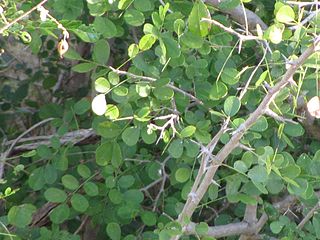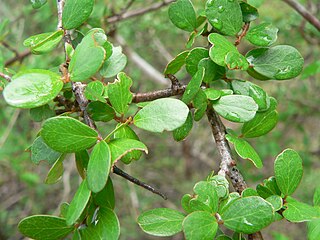
Dalbergia melanoxylon is a flowering plant in the family Fabaceae, native to seasonally dry regions of Africa from Senegal east to Eritrea and south to the north-eastern parts of South Africa. The tree is an important timber species in its native areas; it is used in the manufacture of musical instruments and fine furniture. Populations and genomic resources for genetic biodiversity maintenance in parts of its native range are threatened by overharvesting due to poor or absent conservation planning and by the species' low germination rates.

The Madagascar subhumid forests are a tropical moist broadleaf forest ecoregion that covers most of the Central Highlands of the island of Madagascar. They are included in the WWF's Global 200 list of outstanding ecoregions. Most of the original habitats have been lost due to human pressure.

Cryptocarya agathophylla is a member of the laurel family, Lauraceae, and originates in Madagascar.
Appert's tetraka or Appert's greenbul is a small passerine bird endemic to the south-west of Madagascar. The species was only described in 1972, and has been the subject of considerable taxonomic confusion. It was initially placed in the greenbul genus Phyllastrephus, and later with the Old World warblers in the genus Bernieria. Recent research indicates it is part of an endemic Malagasy radiation currently known as the Malagasy warblers.
Dalbergia baronii is a species of flowering plant in the legume family Fabaceae. It is endemic to Madagascar. It is named after the English missionary and botanist Rev. Richard Baron.
Dalbergia erubescens is a species of legume in the family Fabaceae. It is found only in Madagascar. It is threatened by habitat loss.
Dalbergia pseudobaronii is a species of flowering plant in the legume family Fabaceae. It is endemic to Madagascar. Its leaves are similar to those of Dalbergia baronii, which gave the species its name.
Leptolaena abrahamii is a species of flowering plant in the family Sarcolaenaceae. It is found only in Madagascar. Its natural habitat is mid-elevation humid tropical forests. It is threatened by habitat loss.
Lemurophoenix halleuxii is a species of palm tree, the only species in the genus Lemurophoenix. It is found only in Madagascar. It is threatened by habitat loss and overcollection. There are perhaps 300 mature individuals remaining in the wild.

Khaya madagascariensis is a species of plant in the family Meliaceae. It is found in Comoros and Madagascar.
Melanophylla alnifolia is a species of plant in the Torricelliaceae family. It is endemic to eastern Madagascar. Its natural habitat is tropical moist lowland and montane forests. It is threatened by habitat loss.

Zombitse-Vohibasia is a national park in the Atsimo-Andrefana region of south-west Madagascar. It is 147 kilometres (91 mi) north-east of the town of Toliara, the site of the nearest airport, and the Welcome Office is at Sakaraha 10 kilometres (6.2 mi) from the park entrance. The park covers a surface of 36,308 hectares on three sites; the forest of Zombitse and the sites of Isoky Vohimena and Vohibasia. The Bara people and Mahafaly people are the main ethnic groups in the area.

Hubbard's sportive lemur, or the Zombitse sportive lemur, is a sportive lemur endemic to Madagascar. It has total length of about 51 to 59 cm, of which 23–25 cm (9.1–9.8 in) are tail. Hubbard's sportive lemur is found north of the Onilahy River and south of the Mangoky River in Zombitse-Vohibasia National Park in southwestern Madagascar, living in dry transitional forests. The species listed as endangered by the International Union for Conservation of Nature (IUCN) and is threatened by habitat loss and degradation, forest fires, and unsustainable levels of hunting.

Paroedura masobe, also called masobe hecko, is an endangered species of reptile from the genus of geckos. They are the most abundant species in the Gecko family and are known for their white-speckled dark skin and big eyes. The average life span of the Paroedura masobe is approximately eight years. The average length of the masobe gecko is 0.16 m.
Coffea abbayesii is an endangered species of flowering plant in the family Rubiaceae. It is endemic to Madagascar. It was described by Jean-François Leroy in 1961.
Dalbergia stevensonii, also called Honduras rosewood, is a Central American tree species in the legume family. It grows in broadleaf evergreen swamp forests in southern Belize and adjacent Guatemala and Mexico. The wood is highly valuable, which has led to population loss from illegal logging.
The Kirindy serotine is a species of vesper bat in the family Vespertilionidae. It occurs in the central and south-central portions of western Madagascar. As of the most recent IUCN assessment in May 2016, it is of least concern.
Pandanus connatus is a species of plant in the family Pandanaceae native to northern Madagascar.
Analavelona, also known as Analavelona Massif, is a mountain in southwestern Madagascar. The massif is home to an enclave of montane subhumid forest, which is considered a sacred forest by the local people and notable for its biodiversity.
Spondias tefyi is a species of flowering plant in the cashew family, Anacardiaceae. It is endemic to Madagascar, and is the only known species of genus Spondias native to the island.







